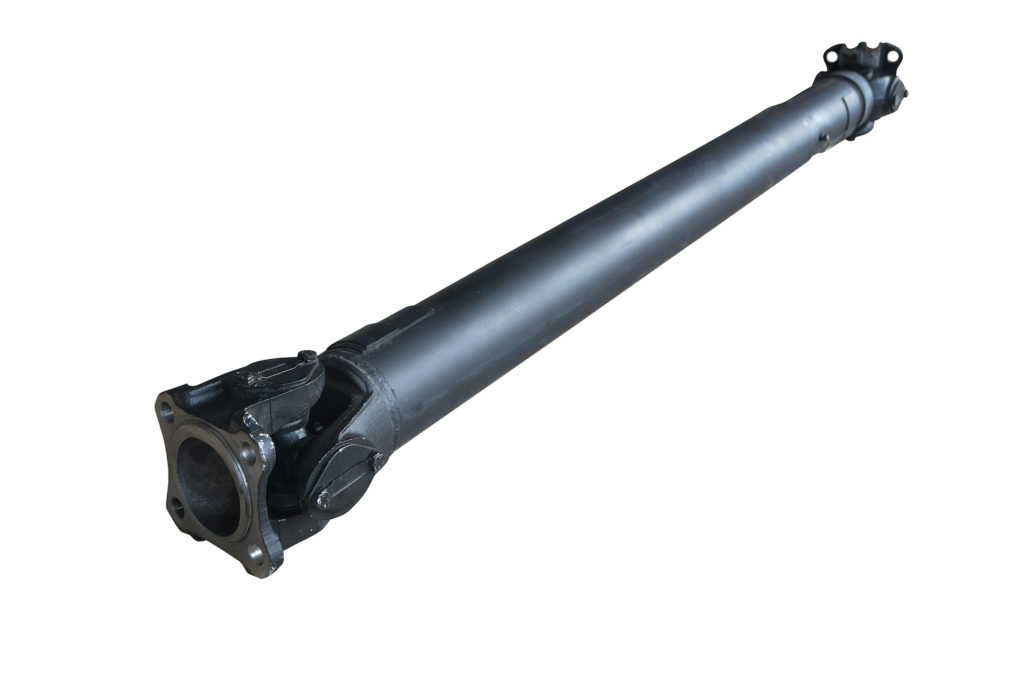Some vehicles have a driveshaft that connects the transmission (or transfer case) to the differential. Although the entire driveshaft rarely fails, its joints and other components can wear out over time. When that happens, you’ll likely notice your vehicle exhibiting some undesirable symptoms.
Bad Driveshaft Symptoms
Driveshafts (also known as propeller shafts) are used in rear-wheel drive (RWD), four-wheel drive (4×4), and all-wheel drive (AWD) vehicles.

- RWD vehicles have one driveshaft that connects the transmission to the rear differential
- AWD vehicles with a front-wheel drive-biased layout have one driveshaft that connects the transfer case (also known as a transfer unit) to the rear differential
- AWD vehicles with a rear-wheel drive-biased layout and 4×4 vehicles have two driveshafts that connect the transfer case to the front and rear differentials
The entire driveshaft rarely fails unless it suffers some type of impact damage. Instead, what tends to go bad are the individual components that make up the driveshaft.
A typical driveshaft assembly is comprised of the following parts:
- One or more tubes that act as the body of the assembly
- U-joints and/or constant velocity (CV) joints that allow the assembly to move up and down
- Yokes and flanges that connect the assembly to the transmission (or transfer case) and the differential
- Long driveshafts also have a center support bearing that supports the middle portion of the shaft

When one of these components fails, you’ll likely notice one or more of the following driveshaft problems:
Abnormal Noises
Driveshaft issues can result in abnormal noises. When the driveshaft’s joints are worn or need grease, they often make a clicking, squeaking, or grinding noise when the vehicle is in motion. A worn center support bearing can also make a growling sound.
Vibrations
In many cases, driveshaft problems will cause a vibration that’s felt throughout the vehicle at higher speeds. The root cause of the problem is often a faulty joint or center support bearing. A driveshaft that is out of balance, out of phase, or at an incorrect angle can also cause vibrations.
Clunking Sensation
Worn driveshaft joints can often cause a clunking sensation. The driver will typically notice the problem when changing gears or switching between forward and reverse. Also, a worn center support bearing can cause a clunking sensation when the vehicle travels over bumps.

How To Tell If Your Driveshaft is Bad
Other issues can mimic a bad driveshaft. So, you must perform a thorough inspection to determine whether the driveshaft is to blame. The following steps will give you an idea of what to look for.
Visually Inspect the Entire Driveshaft
First, you’ll want to perform a visual inspection of the entire driveshaft. Look for obvious problems, such as dents in the driveshaft tube, that could cause an out-of-balance condition and a vibration. You’ll also want to check for undercoating or excessive mud, as such problems can upset the balance of the driveshaft.
Check the Joints and Bearings for Excessive Movement
You can check the joints for excessive movement by grabbing the driveshaft and moving it up and down. Turning the driveshaft and the yoke (by hand) in opposite directions can also reveal problems with the joints.
It’s important to note that some joint issues can go unnoticed when the driveshaft is still installed in the vehicle. You may need to remove the driveshaft to perform a thorough inspection of the joints. Before removal, remember to mark and index the driveshaft to the differential’s yoke or flange to ensure the shaft is reinstalled in the same position.
If your vehicle has a center support bearing, you’ll also want to check the bearing by rotating the inner race by hand while holding the outer race. The bearing’s rubber insulator can also be checked by moving the driveshaft up and down while it’s installed in the vehicle.

Check the Balance, Angle, and Phase of the Driveshaft
Usually, outside influences—such as impact damage and improper service—are the only reason a driveshaft might suffer from improper balance, angle, or phase.
A driveshaft that has incurred impact damage may be out of balance. Most professionals check the balance of the driveshaft by measuring its “runout” with a dial indicator.
It’s also possible for a driveshaft that’s been taken apart and reassembled incorrectly to have an improper angle or phase. The angle is just what it sounds like—the angle at which the driveshaft sits in relation to the vehicle. On the other hand, phase refers to the angle of the u-joint yokes in relation to one another. Professionals typically use an inclinometer to check for both of these conditions.
Watch this video to get an idea of how to replace a rear driveshaft:
Any information provided on this Website is for informational purposes only and is not intended to replace consultation with a professional mechanic. The accuracy and timeliness of the information may change from the time of publication.





























